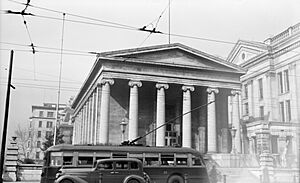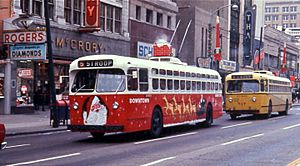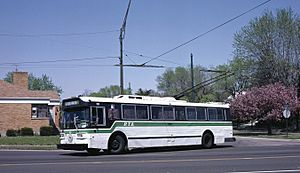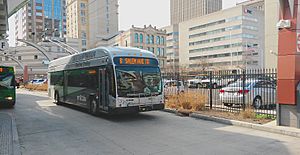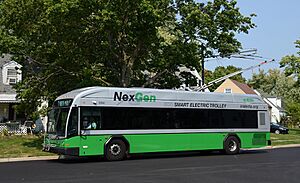Trolleybuses in Dayton facts for kids
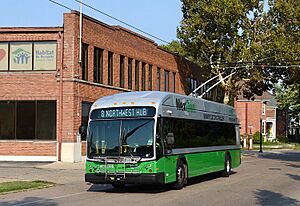
A Gillig/Kiepe trolleybus on Riverview Avenue, 2021
|
|
| Operation | |
|---|---|
| Locale | Dayton, Ohio, U.S. |
| Open | April 23, 1933 |
| Operator(s) | 1933–72: Various private companies (see table in article); 1972–present: Greater Dayton Regional Transit Authority |
| Infrastructure | |
| Electrification | Parallel overhead lines, 600 V DC |
| Stock | 45 Gillig Low Floor |
| Statistics | |
| Passengers (Annual ridership) | 1,813,600 (2022) |
| Website | i-riderta.org |
The Dayton trolleybus system is a special type of electric bus network in Dayton, Ohio, USA. It's like a bus, but it gets its power from overhead electric wires, similar to a train! This system started way back on April 23, 1933. Today, it has five main routes and is run by the Greater Dayton Regional Transit Authority (RTA). They use a fleet of 45 modern trolleybuses.
Dayton's trolleybus system is quite unique. It's one of only a few still running in the U.S. and the only one in a city without a subway or light rail. It's also the longest continuously running electric transit service in the United States. This service started in Dayton in 1888 with streetcars. Because of its long history, Dayton's trolleybuses are a local symbol of the city.
Contents
History of Dayton's Electric Buses
The first electric trolleybus service in Ohio began in Dayton on April 23, 1933. This happened when the Salem Avenue-Lorain Avenue streetcar line was changed to use trolleybuses. Electric streetcar service had been running in Dayton since 1888. The very last streetcar line in Dayton was changed to trolleybuses on September 28, 1947.
Today, Dayton's trolleybus system is the second-oldest in the Western Hemisphere. Only the Philadelphia system, which opened in 1923, is older.
Why Dayton Started Using Trolleybuses
The first trolleybus line in Dayton was opened by the Dayton Street Railway company (DSR). They decided to switch to trolleybuses after a big fire in 1932. This fire destroyed their building and many streetcars and buses. After looking at other cities' trolleybus systems, DSR ordered 12 new trolleybuses. These started service in April 1933.
Dayton was unusual because several different companies ran transit services at the same time. By 1930, most U.S. cities had only one company. But in Dayton, five separate streetcar companies were operating in 1933. All five of these companies eventually switched some or all of their routes to trolleybuses between 1933 and 1940.
Who Operated Dayton's Trolleybuses?
Here's a look at the companies that have operated Dayton's trolleybuses:
| Name | From | To | Notes |
|---|---|---|---|
| Dayton Street Railway Company | April 23, 1933 | April 28, 1941 | This company was later bought by City Railway Company. |
| Oakwood Street Railway Co. (OSR) | January 19, 1936 | October 1, 1956 | This company was bought by City Transit Company. |
| Peoples Railway Co. (PR) | October 11, 1936 | March 9, 1945 | This company was bought by City Railway Company. |
| City Railway Co. (CR) | March 25, 1938 | October 31, 1955 | This company joined with Dayton-Xenia Railway Co. to form City Transit Company. |
| Dayton-Xenia Railway Co. (DXR) | October 1, 1940 | October 31, 1955 | This was the last new system to open. It joined with City Railway Co. to form City Transit Company. |
| City Transit Company (CT) | November 1, 1955 | November 4, 1972 | This company was formed by two others joining. It was taken over by a new public group in 1972. |
| Miami Valley Regional Transit Authority (now Greater Dayton RTA) | November 5, 1972 | present | This is the current operator. Its name changed to GDRTA in 2002. |
For about seven months starting in October 1940, Dayton had five different trolleybus systems. It was the only city in the world to have so many independent systems at the same time!
After 1955, the City Transit Company ran all public transportation in Dayton. Then, on November 5, 1972, the system became publicly owned. The new Miami Valley Regional Transit Authority (MVRTA) took over. MVRTA later changed its name to the Greater Dayton Regional Transit Authority (GDRTA) in 2002, often called just RTA.
The RTA decided to keep the trolleybuses running. In the mid-1970s, they replaced the old buses with 64 new Flyer E800 models. These arrived in 1977.
In the late 1980s, it looked like the Dayton trolleybus system might close. The RTA board voted in 1988 to stop using them. But this decision was changed in 1991. A study showed that keeping the trolleybus service was the best choice in the long run. It was also better for the environment. After this, RTA started fixing up its Flyer trolleybuses. This made sure they would work well until new ones could be bought.
Between 1996 and 1999, the Flyer buses were replaced. A new fleet of 57 buses was built by Electric Transit, Inc. (ETI). These were based on a model from the Czech company Skoda. The final assembly of these buses happened in Dayton.
The ETI buses were later replaced in the late 2010s. A new fleet of 45 dual-mode trolleybuses arrived. These were built by Gillig and Kiepe Electric. The last ETI buses were retired in October 2019. The final new Gillig/Kiepe buses started service in December 2020.
Current Trolleybus Routes
In the 2010s, trolleybuses ran on seven RTA routes. These routes have been the same since 1988, but some changes have been made to their paths or how often they run. The routes are:
- 1 East Third Street / West Third Street
- 2 Lexington / East 5th Street
- 3 Wayne Avenue
- 4 Hoover / Xenia-Linden
- 5 Valley Street / Far Hills
- 7 North Main / Watervliet
- 8 Salem / Lakeview
(A slash means a route goes in two different directions from downtown Dayton.)
Trolleybuses usually ran all the service on routes 4, 5, 7, and 8. Routes 1, 2, and 3 used trolleybuses only for a few trips during weekday rush hour. Otherwise, these routes used diesel or hybrid buses.
In 2019–2020, new trolleybuses arrived that could run without overhead wires for a while. Because of this, trolleybus use on route 1 was expanded to all day. Weekend trolleybus service also started again in January 2021. This was the first time since May 2010 that trolleybuses ran on weekends. Route 2 has not used trolleybuses since early 2019. However, RTA plans to bring trolleybus service back to this route all day after power system upgrades. In June 2021, all service on routes 3 and 5 was stopped for a while. In 2024, the city of Oakwood decided to remove all trolleybus wires from their area. They thought the wires didn't look nice.
Trolleybus Fleet
Past Trolleybuses
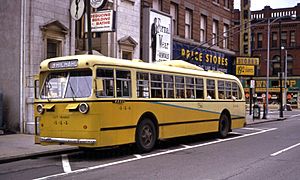
Dayton's first trolleybuses were made by the J. G. Brill Company in 1933. Later, they bought more Brill buses, plus others from Pullman-Standard and Marmon-Herrington. Many of these were new. But between 1956 and 1965, the City Transit Company also bought used trolleybuses from other cities. They got 21 Brill buses from Little Rock, Arkansas, and Indianapolis, Indiana. They also got 75 Marmon-Herrington buses from four cities: Little Rock, Cincinnati, Ohio, Columbus, Ohio, and Kansas City, Missouri.
By the end of the 1960s, most of the old Brill and Pullman trolleybuses were retired. The Marmon-Herrington trolleybuses made up almost the entire fleet when the system became publicly owned in 1972.
In 1971, the City Transit Company bought a special trolleybus, a Flyer E700A. It was the first new trolleybus bought by any U.S. transit system since 1955. This bus, number 900, used electric parts from older buses but was mostly new. The MVRTA took over the system in late 1972, including this new bus.
MVRTA ordered 64 Flyer E800 trolleybuses in January 1975. The first ones arrived in late 1976, and the rest came in 1977. These were Dayton's first trolleybuses with air conditioning. Wheelchair lifts were added to them in 1983. The last Marmon-Herrington trolleybuses were taken out of service in October 1982. After that, Flyer trolleybuses were the only ones used until the mid-1990s. In 1995, RTA also got two older trolleybuses from Canada.
RTA planned to replace its 1976–77 Flyer buses when they were about 20 years old. In 1994, they ordered 63 new trolleybuses from Electric Transit, Inc. This order was later changed to 57 buses. These new buses replaced all the Flyer buses between 1996 and 1999.
ETI Trolleybuses
Dayton's first ETI trolleybuses were three test models built in 1995. They arrived in late 1995 and early 1996. These were model 14TrE. The "E" meant "export" because this model was designed for the North American market. This market had different rules than Europe, like needing wheelchair lifts. Skoda was one of the biggest trolleybus makers in the world. They had been making versions of their 14Tr model since 1974.
The "E2" in the model name meant it was the second version for export. It had changes after testing the first three. For example, the wheelchair lift was moved to the front door. This change also made the bus body wider. The three test ETI buses started service in April 1996. The main group of 54 ETI buses arrived between January 1998 and September 1999. By 2004, the three test buses were no longer used regularly. They were retired in 2006 because RTA had trouble finding parts for them.
By 2013, 35 of the 54 main ETI buses were still in use. RTA started planning to buy new buses to replace them. They wanted to order new buses by 2016. After testing four new Gillig/Kiepe dual-mode trolleybuses, RTA ordered 41 new ones with batteries. These were delivered in 2019 and 2020. The last Skoda/ETI trolleybuses were retired in October 2019.
Current Trolleybus Fleet
Dayton's current trolleybus fleet has two types of buses: two model DMDT and 43 model DMBT.
| Fleet numbers | Image | Quantity | Manufacturer | Electrical equipment |
Model | Configuration | Year built | Notes |
|---|---|---|---|---|---|---|---|---|
| 1401–1402 |  |
2 | Vossloh Kiepe/Gillig | Vossloh Kiepe | DMDT (with Gillig BRT Plus body) | Standard (two-axle), low-floor | 2014 | These were test buses. |
| 1403–1404 | 2 | DMBT (with BRT Plus body) | ||||||
| 1951–1971 2051–2070 |
 |
41 | Kiepe/Gillig | Kiepe Electric | DMBT (with BRT Plus body) | 2019–2020 | ||
| Model abbreviations: DMDT: Dual-mode diesel/trolley. DMBT: Dual-mode battery/trolley. | ||||||||
Dual-Mode Buses Explained
In May 2013, RTA ordered four test low-floor, dual-mode buses from Vossloh Kiepe. The first one arrived in September 2014. Gillig made the bus bodies, and Vossloh Kiepe put in the electric parts. All four can run as trolleybuses. But for running without wires, two use a diesel engine to make power (like a hybrid bus), and two use only batteries.
These new buses were called "NexGen" (Next Generation) by RTA. The test buses started service in early 2015. They ran in both trolley mode and diesel or battery mode to see how well they worked. After testing, RTA chose the design that uses batteries for running without wires. These are buses 1403 and 1404.
In 2016, RTA decided to buy at least 26 more dual-mode buses. In January 2018, RTA ordered 26 more buses from Kiepe Electric. These were the same type as the battery-powered test buses (1403–1404). Gillig provided the bus bodies. In November 2018, RTA ordered another 15 buses of the same type.
In April 2018, one of the test buses (No. 1404) was repainted. It got a new green-and-silver paint scheme. RTA said this would be the color for all the new buses. By 2021, all four test buses had been repainted in these new colors.
The 41 new Gillig-Kiepe trolleybuses arrived in 2019 and 2020. The first one started service in November 2019. By October 2019, enough new buses had arrived to replace all the older Skoda/ETI trolleybuses. The last 10 new Kiepe trolleybuses started service in December 2020.
Preserved Trolleybuses
Several old Dayton trolleybuses have been saved for history. Some are in museums. The unique 1971 Flyer E700A No. 900 is kept by RTA, but you can't see it publicly. The 1949 Marmon-Herrington trolleybus 515 is also kept by RTA. It ran special trips between 1984 and 1987. Since 1988, it has been on display at the Carillon Historical Park in Dayton. Another Marmon-Herrington, No. 501, is stored by RTA.
Other saved buses include Flyer E800 Nos. 916, 937, and 953. Also, ex-Edmonton BBC HR150G Nos. 109 and 110, and Skoda/ETI Nos. 9602, 9834, and 9835 are kept by RTA but not for public viewing. The Illinois Railway Museum has ex-Dayton Pullman trolleybus 435, two ex-Dayton Flyer E800s (Nos. 906 and 925), and ex-Dayton Skoda/ETI 9809. Skoda/ETI 9803 was sent back to the Czech Republic. It is on display at a public transport museum in Strašice, near Plzeň.


